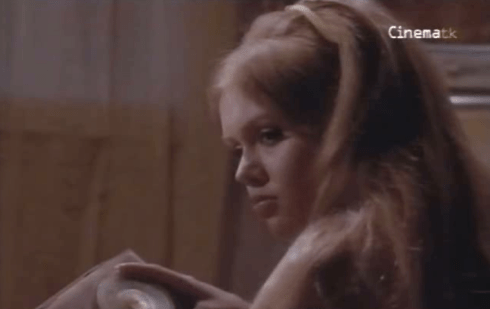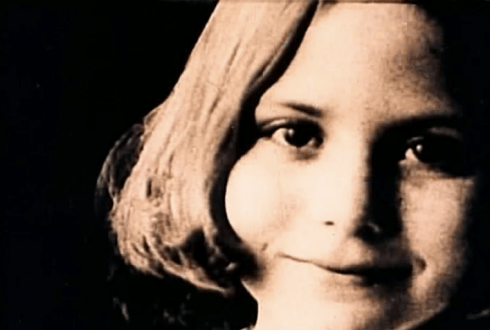THE SEVEN MINUTES 1971
The Seven Minutes 1971 is based on a novel by Irving Wallace. Directed by provocateur Russ Meyer (Lorna 1964), Faster, Pussycat, Kill! Kill! & Mudhoney(1965) with a screenplay by Richard Warren Lewis and an uncredited Manny Diez. This film comes on the heels of his hit at FOX with Beyond the Valley of the Dolls 1970. (Dolls with a screenplay by Roger Ebert) Meyer and Fred Mandl (Checkmate, The Munsters, The Twilight Zone, The Fugitive) create a great visual romp with the cinematography. The opening titles roll over the first almost seven minutes of the film as we hear the ticking of a clock…
With a very unusual cast of character actors starring Wayne Maunder as Mike Barrett, and Marianne McAndrew  (Hello Dolly 1969, The Bat People 1974) as Maggie Russell. Philip Carey (I’ve always been amazed at how much he reminds me of Charlton Heston) as District Attorney Elmo Duncan.

The awesome Jay C. Flippen as Luther Yerkes, Edy Williams as Faye Osborn, Lyle Bettger as Frank Giffith, Stanley Adams as Irwin, Jackie Gayle as pornographer Norman Quandt, Ron Randell, Charles Drake, Olan Soule and John Carradine as Sean O’Flanagan, Harold J. Stone and Yvonne De Carlo as Constance Cumberland.



Music by Stu Phillips (Quincy M.E.) with Lionel Newman supervising. BB King sings Seven Minutes.
‘The Seven Minutes’ refers to an artistically erotic banned book published thirty-five years ago in Paris, that essentially opens up the floodgates for the public discourse about pornography, censorship, violence against women, and the dual standards during a time when morality was ambiguous. You know, just like today.


A bookstore clerk is indicted for selling obscene material which leads to a court trial. There is also the question as to whether this licentious book actually led to the rape of a young girl. The film is part trial based as the defense lawyers try to hunt down any clues that would prove the author of the book was not a smut merchant but trying to express an artistic viewpoint that can not be silenced by censorship.

The author and the mystery surrounding their identity are key to the plot. Meyers does a high-spirited job of developing this narrative with engrossing scenes that portray a society of zealots and self-serving neophytes in turmoil with themselves. All amidst a groovy 70s palate that’s nostalgic and filled with a colorful verisimilitude.
The film opens with some great 70s devil may care by composer Stu Phillips. At first, we see a beauty chasing her dog passed a small storefront. The story reveals that the vice bureau is staking out the ARGUS bookstore, as Sgt Kellogg (Charles Drake) walks in with his cigarette box tape recorder ready to entrap the clerk for selling smut. He asks the young bookseller for something ‘brand new -unusual, ‘something you wouldn’t find in an ordinary library.’ The clerk (Robert Maloney) just tells him to look around, the jackets tell the story pretty well.
Kellogg casually asks for one particular book on display The Seven Minutes by JJ Jadway and the bookseller repeats the title ‘Oh yeah” Kellogg remarks, “That’s a pretty sexy cover ain’t it?” As Kellogg ogles the pretty blonde talking to the young clerk who tells him she’ll see him later.
Sargent Kellogg (Charles Drake) “You read it?” Clerk -“The new addition at least… the first one was banned thirty-five years ago.” Kellogg-Â “How come it was banned?” Clerk– “Cause it was considered obscene” Kellogg-Â “Do you think the book’s obscene?” Clerk– “Why don’t you buy the book and find out for yourself.” “How much is it?” ” $7.30 with the tax.”
“Wrap it up… You the manager around here?” Clerk-“Yeah, the day manager.” Kellogg-“Who do I bring it back to if I don’t like it” The clerk answers– “Fremont, Ben Fremont.” Kellogg waves.
Kellogg’s partner is tape-recording the conversation from the car. “Took you long enough.” “Literary conversations take a little doing, we better start comparing, same jacket same title, same publisher, same publishing date, and copyright… Let’s pay Mr. Fremont another visit.”
They arrest him for knowingly selling obscene matter which is a misdemeanor in the state of California. And this starts the ball rolling in this film. As the powers that be, seek out district attorney Duncan who feels that The Seven Minutes would be found obscene if taken to court.





Check out that cherry Volkswagon and Corvette, check out that cool 70s phallus phone, Check out that really young Tom Selleck as the publishing guy… who calls hot shot attorney Michael Barrett (a very cool Wayne Maunder) who is representing the publisher Phil Sanford (Tom Selleck) who’s in a panic about the book clerk Fremont going to jail for selling one of Sanford House’s books.
The tower of self-righteousness Elmo Duncan the D.A. (Phillip Carey) wants to be propelled into the Senatorial seat in California. The powers that be who want him to become Senator conspire to exploit this contrived issue of corruption & decency so Duncan has a powerful platform to run on. This elite cabal wants to build a state-wide case in which Elmo Duncan can fight the ‘Smut Merchants.’



They have a political agenda to stamp all youthful violence incited by salacious material in reading matter and films, and so this cause has become the lynchpin with which they hope to win an election, making ‘The Seven Minutes’ the subject of their campaign.
Meanwhile, a violent rape takes place involving the son Jerry (John Sarno) of a wealthy advertising tycoon Frank Griffith (Lyle Bettger) who owns a copy of The Seven Minutes and was present at the time of the assault committed by his psychotic friend, the one who actually commits the brutal rape.
The rape scene is handled with quick cuts interwoven with Wolf Man Jack doing his thing on the air. It’s all very frenetic as the soundtrack “love train” is sung by Don Reed.
The prevailing secret surrounding pathetic Jerry Griffith (John Sarno) is that he’s been emasculated by his domineering father and now can’t get it up, so he’s impotent sexually and in helping Sheri Moore (Yvonne D’Angers) while she’s being attacked by his violent friend.
Jerry takes the blame for the rape and refuses to talk about it, thereby implicating himself as an impotent sissy and allowing the lynch mob and voyeurs to assert that Jerry would not have committed such an act if The Seven Minutes hadn’t been available to him. Duncan is now convinced that a clean boy wouldn’t have done the crime if it weren’t for the availability of the dirty book.

These hypocritical old cronies have young girls of their own on the side, watching pornography while salivating at the mouth. Yerkes has a girlfriend he calls ‘baby doll’ who dances provocatively for these guys. She’s got ample boobs (It is a Russ Meyer film after all) hanging out of her 70’s style yellow hot pants. Amidst the interesting subject matter Shawn ‘Baby Doll’ Devereaux gyrates and inserts herself into the frame to show us the hypocrisy of these old farts who condemn others for their own personal agenda all the while being the worst kind of purveyors of sinful behavior.

Russ Meyer had his own dealings with censorship so the subject is probably of very personal substance for him. He does a fantastic job of pointing out the duality of persuasions. And he builds the story really well here. Showing the belligerence by equal sides of the coin toward a moral center and a society ripping at the shreds of personal freedom to express, create and destroy.
Whether you’re an avid Russ Meyers fan or just think you might like to venture into the complex questions the film evokes, presented in that real 70s style The Last Drive In weeps for most days, it’s a film worth watching, even just to spot the few character actors that pop up on the screen like baby doll’s and Faye Osborne’s (Yvonne & Edy) eh hems… well you know… the cleavage shot!
What appears on the surface as a controversy surrounding a banned book that contains alleged salacious material-The defense evokes some good examples of Henry Miller’s ‘Tropic of Capricorn’ or, D.H. Lawrence’s ‘Lady Chatterley’s Lover’, etc.
What manifests is an interesting commentary on censorship, masculinity, and the spurious connection between perceived immoral content and violence in society.
Manhood and masculinity is a texture that is not necessarily used as the theme in the story, but let me tell you it is all-pervasive with images of Duncan heaving his heavyweights as he sweats and works out in front of Mike, spouting his holier-than-thou rhetoric. It was almost masturbatory.
He gave Michael that “politician’s holier than thou number” Duncan was hostile while he pumped weights in front of the intellectual Mike Barrett. Dueling of masculinity and the question of causality with pornography and violence against women.
Duncan talks to a church official about ‘freedom’ Duncan–Â “We only want to penalize those who would corrupt it.”
Duncan and his reprehensible comrades belong to a group called Strength Through Decency.
The acronym STD... was this intentional? Probably. It’s hilarious as these types of organizations do spread like a social disease. They’re against lust, motorcycles, homosexuals, and lesbians. All the factors that made the 70s so dangerous of course. Those lustful lesbians on motorcycles riding down 5th Avenue in NYC wreaking havoc with our delicate morality. Why I’m surprised we all survived it…
So as much as the words “smut merchants’ are bandied around, and the question of censorship takes priority in full view, the underlying sub-context is the posturing of masculinity and the double standard of sexism & classism and who gets to play and who must obey.

I won’t get into the story behind the mystery or the trial, the story behind Jerry’s impotence, the elitism, or the ultimate reveal about the author of The Seven Minutes. The media frenzy that occurs feeds on the sensationalism of the situation who condemn the book but want to hear about the details of rape victim Sherri’s violation.
Is The Seven Minutes a beautiful novel about a woman’s awakening or really filthy trash? You’ll have to find out… but I’ll say that Russ Meyer’s The Seven Minutes is a great addition to the socially conscious sexually charged films of the late 60s & 70s like Roger Vadim’s Pretty Maids All In a Row, and Robert Thom’s Angel, Angel Down We Go 1969…
Your ever-loving MonsterGirl.

















































































































































